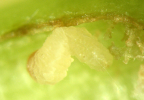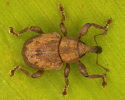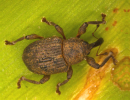 |
|
The water hyacinth weevils, Neochetina bruchi Hustache and N. eichhorniae Warner (Coleoptera: Curculionidae), are native to South America. They were introduced in India in 1983 for the biological suppression of water hyacinth (Eichhornia crassipes (Mart) Solms.), which is one of the most serious aquatic weeds in India. The weevils have been introduced in at least 15 Indian states and are established in Assam, Andhra Pradesh, Gujarat, Karnataka, Kerala, Maharashtra, Punjab and Tamil Nadu. Distinguishing features between Neochetina bruchi and N. eichhorniaeO'Brien (1976) revised the genus Neochetina and provided descriptions and a key to species. An interactive key to these two species is also available at http://www.famu.org/weeviltool/. A brief account of the two species is given below. |
 |
Common nameChevroned water hyacinth weevil
Diagnosis
|
 |
Common nameMottled water hyacinth weevil
Diagnosis
BiologyThe general biology of N. bruchi and N. eichhorniae is more or less similar and the immature stages also closely resemble each other. Eggs are deposited directly within the tissues of
water hyacinth. Adult females make a hole in the lamina or petiole of the leaf and deposit a single egg. Eggs may also be deposited around the edges of adult feeding scars. The weevils prefer to lay eggs in the tender central leaves or ligules surrounding the leaf bases.

 Eggs
EggsLarvae of both species are similar in external appearance. They are white or cream coloured with a yellow-orange head. They are apodous (legless) The posterior end of the body is blunt with a pair of dorsally projecting spiracles that the insect is thought to insert into the plant tissues to extract oxygen. There are three larval instars - the first instar larvae are very small (2 mm long); the full grown (third instar) larvae are grub-like, C-shaped, and 8-9 mm long. The larvae feed within the bases of leaves and petioles, occasionally entering the apex of the stem, where they destroy the apical bud. 


 Larva of Neochetina sp. feeding on water hyacinth Pupae of both species are similar in external appearance and difficult to distinguish. They are creamy white and enclosed within a cocoon that is formed among the lateral rootlets below the water surface. Pupae within their case have the appearance of small "balls" about 5 mm in diameter typically on roots near the stem. Production and field releaseSingh (1994a, b) detailed the methods for the multiplication of the weevils in portable or permanent water tanks and pools, their field release and impact assessment.

 Plastic-lined, portable, aluminium tanks used for the mass production of Neochetina spp. References
|










